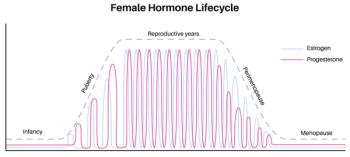
Case 1:
A 3-day history of intermittent fainting spells brings a 49-year-old man to youroffice. His only significant medical history includes seasonal allergic rhinitis,for which he takes terfenadine, and mild depression, which is being treatedwith amitriptyline. A week ago, he began taking erythromycin, 500 mg qid,for acute pharyngitis.
Intermittent Syncopein a Middle-Aged Man
A 3-day history of intermittent fainting spells brings a 49-year-old man to youroffice. His only significant medical history includes seasonal allergic rhinitis,for which he takes terfenadine, and mild depression, which is being treatedwith amitriptyline. A week ago, he began taking erythromycin, 500 mg qid,for acute pharyngitis.Based on the tracing, what is the most likely cause of the patient'ssyncope?
A.
Torsades de pointes.
B.
Myocardial ischemia.
C.
Hyperkalemia with ventriculararrhythmia.
D.
Intermittent heart block.
Case 1. Intermittent syncope in amiddle-aged man. Answer: A.
Thetracing demonstrates significantQT-segment prolongation. This is theECG substrate for the development of
torsades de pointes,
a form of polymorphicventricular tachycardia. It is oftenseen in young patients without significantcardiac histories. The disordercan be congenital (the long QT syndrome)or drug-induced. In this case,the patient was taking 2 medications(amitriptyline and terfenadine) thatcan prolong repolarization (lengthenthe QT segment). The addition of ahepatic cytochrome P-450 inhibitorsuch as erythromycin may haveraised the serum concentration ofthese medications, resulting in torsadesde pointes.This patient was admitted overnightfor telemetry monitoring. Hismedications were discontinued, andhis condition resolved.
Epigastric Burningin a Woman With Diabetes
A 55-year-old woman with diabeteshas had severe epigastric burning forthe past 4 hours. She denies chestpain or shortness of breath.Which of these conditions doesthe tracing suggest?
A.
Acute pericarditis.
B.
Acute inferior wall myocardialinfarction/injury.
C.
Lateral wall myocardial infarction.
D.
B
and
C.
Case 2. Epigastric burning in awoman with diabetes. Answer: D.
The most salient feature of this ECGis the "tombstone" ST-segment elevationin the inferior leads, coupled withsmall Q waves in leads III and aVF.This is consistent with an evolving
inferiorwall myocardial infarction
and ismost frequently attributable to completeocclusion of the right coronaryartery. Note also that there is someST-segment elevation in lead V5,which probably reflects
lateral wallinvolvement.
In addition, ST-segmentdepression in the anterior precordialleads raises the question of posteriorwall involvement. Treatment with eithera thrombolytic agent or emergentpercutaneous transluminal coronaryangioplasty is the appropriatenext step.
Nausea and Vomiting in a Young Man
A 19-year-old man complains of nausea, vomiting, dizziness, and fatigue. AnECG is obtained in the emergency department (A); a second one is obtained4 hours later (B).What intervention has been performed that explains the dramatic change?
A.
Emergent percutaneous transluminal coronary angioplasty.
B.
Intravenous administration of sodium bicarbonate and calcium, followedby dialysis.
C.
Intravenous repletion of magnesium sulfate.
D.
Treatment with a positive inotropic agent.
Case 3. Nausea and vomiting in a young man. Answer: B.
The first tracingdemonstrates a wide-complex junctional rhythm in the setting of
severehyperkalemia.
A number of important features suggest this diagnosis. First,the classic appearance of a "sine wave" is seen in the precordial leads; thisoften heralds death. Peaked T waves are also present in the lateral precordialleads, and no easily identifiable J point (the juncture between the end of theS wave and the ST segment) is seen. The ST segment and the T wave forma single rounded complex (almost fused, with no clear ST segment).The patient had been taking 2 potassium-sparing medications (spironolactoneand an angiotensin-converting enzyme inhibitor) for idiopathic cardiomyopathyand suffered renal failure as a result of the medications and dehydration.Immediate intravenous treatment with 10 mL of 10% calcium gluconatesolution, sodium bicarbonate, dextrose with 10 units of insulin, andhemodialysis resulted in normalization of the patient's ECG.
Dizziness and Fatigue With No Chest Pain
A 65-year-old man has had intermittent dizziness and fatigue with exertion for2 months. He has significant difficulty climbing stairs or doing yard work butdenies chest pain.Based on the ECG shown here, what is the most likely cause of theman's symptoms?
A.
Sick sinus syndrome.
B.
Atrial fibrillation with slow ventricular response.
C.
Complete heart block.
D.
Mobitz type 1 second degree atrioventricular block.
Case 4. Dizziness and fatigue withno chest pain. Answer: C.
The ECGshows
complete heart block
(third degreeatrioventricular [AV] block) withan escape rate of 30 beats per minute.The most important feature on thistracing is the presence of AV dissociation.The P waves (arrows) marchthrough without a consistent relationshipto the QRS complex (dissociation).In addition, the R-R interval isconstant, which argues against AVconduction. The QRS duration isabout 120 milliseconds, which maysuggest that the level of the block isbelow the AV node. Unless a reversiblecause is identified, this disorderis treated with a dual chamber AVsequential pacemaker.
Newsletter
Enhance your clinical practice with the Patient Care newsletter, offering the latest evidence-based guidelines, diagnostic insights, and treatment strategies for primary care physicians.

























































































































































































































































































